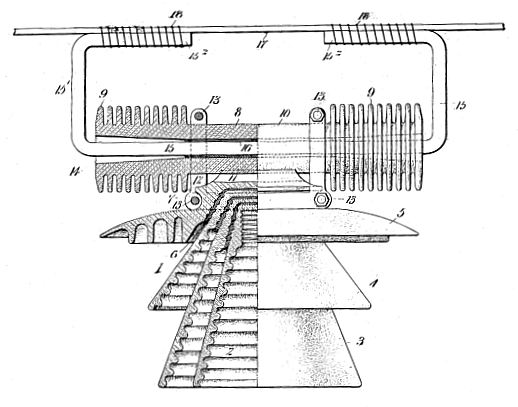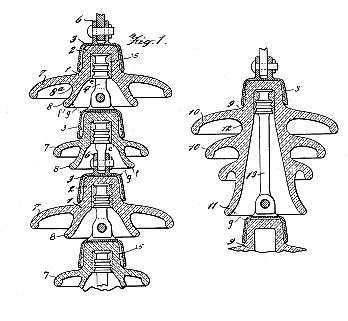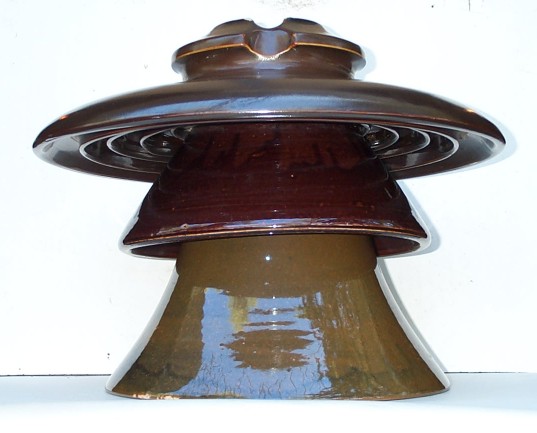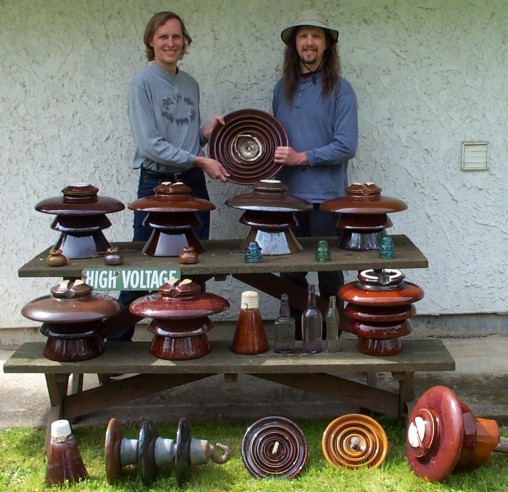
The Baum Ringed Styles
Made by
Lima Insulator Co. and R. Thomas & Sons Co.
Frank G. Baum was granted a patent the concentric ring feature on December 11, 1906 (838,163). Below is the drawing from the patent. Note that the concentric rings were not shown on the top skirt, but rather on the second and third shells. There are four long petticoats provided under the top skirt. This is the first reference to petticoats used under the top skirt on multipart porcelain insulators. The petticoats and concentric rings added length to the leakage path across the surface of the insulator, thus providing a greater resistance. The odd ribbed tubular insulator on top served the same purpose of adding leakage path, but it was suggested that the surface would be easily washed by rain.

Illustration from patent No. 838,163 granted to Frank Baum
on Dec. 11, 1906.
Frank G. Baum was a resident of San Francisco and an electrical engineer. His first project after graduating from Stanford in 1899 was to assist Dr. F. A. C. Perrine in the design of an installation for Standard Electric Companyís Electra Powerhouse on the Mokelumne River in northern California. He also worked as a consultant to the Bay Counties Power Company. Both companies constructed power lines in northern California that used extensively the Fred Locke M-2795 to carry power to San Francisco and surrounding area. M-2795 was unique in that it had a porcelain top with eave gutter and spout and a glass bottom. He later worked four years for California Gas & Electric and opened his own consulting office for a time. He was then a consulting hydroelectric engineer for Pacific Gas & Electric Co. (PG&E). In 1921, he supervised the design and construction of the Pit River development in the Shasta area of northern California. Power was transmitted at a record 220,000 volts 202 miles away to Oakland. The insulators used on that power line could be the suspension insulator in Baumís patent No. 1,768,948 granted to him on July 1, 1930. Below is part of the patent drawing. The patent was assigned to Westinghouse, but note that the patent application was dated December 3, 1921. This may very well be the basic design used at Pit River.

Baum suspension insulator patent assigned to Westinghouse.
Now back to the first Baum patent. A couple of years ago, Paul Greaves and Mike Spadafora discovered a new multipart style in northern California. It was discovered after my new book, Multipart Porcelain Insulators, was at the printer and too late to make it in. I assigned it M-4604. After several searches on two lines in northern California, they ended up with about 5 specimens most of which had to be kitsulated. I believe only one was found whole in nice condition and I believe they told me all of them have the incuse marking, LIMA, N.Y., on the crown. They also thought another similar style was used that did not have the flared bottom skirt. As you can see in these photos, M-4604 has four long thin petticoats under the top skirt exactly as shown in Baumís first patent! The fourth skirt is hard to see up close to the joint. This undoubtedly was the first insulator made from the Baum patent. Lima was in operation only from 1904 to 1908.

Paul Greaves' photo of M-4604 with incuse marking, LIMA, N. Y.

Paul Greave (left) and Mike Spadafora (right) with a few M-4604's (top row) and two M-4600's (top right and middle left). This is a day's haul for these two poleliners.
Ringed Styles: Page 2